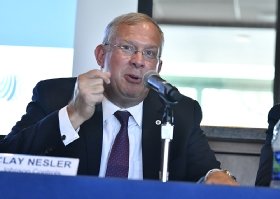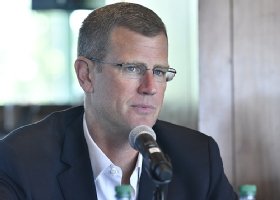
Alexey Brin - Fotolia
Johnson Controls Smart Ready Panel equates smart stadiums to smart cities
Keeping their eyes on the ball, leaders of Fenway Park and the city of Boston explored why it's a home run to adopt smart city infrastructure at the Johnson Controls Smart Ready Panel.
Building smart cities is much like building connected stadiums. With few opportunities to build from the ground up, updating legacy infrastructure is a given -- and a challenging one at that. Plus, people want not only to preserve history, but also to stay connected the way they're accustomed.
Whether it's mayors and city leaders in charge of municipalities or owners and CEOs in charge of stadiums, they know adding new (technology) to old (nostalgia) is key to keeping fans, visitors and residents healthy, happy and protected.
When Red Sox CEO Sam Kennedy joined the organization in 2001, there were talks of tearing the team's park down and relocating it in the city. However, nostalgia ultimately won, and Kennedy and management began to thoroughly examine the park and its future.
Often considered the gold standard of baseball stadiums, Fenway Park may look similar to the structure built in 1912, but much of it has been modified behind the scenes to keep up with the times -- including additional seating, a rooftop garden and the availability of more "social" spaces, where fans can escape the old seats and go to club rooms with friends yet still enjoy the experience of being at a game.
But, looking even further ahead, how do you prepare for a future you're unsure of?
That was the topic of discussion at the recent Johnson Controls Smart Ready Panel at Fenway Park, where Kennedy and fellow panelists discussed how venues, buildings and cities can prepare for a connected future.
Legacy vs. greenfield connected stadiums
Clay Nesler, VP of global energy and sustainability at Johnson Controls, said designers do sometimes get a clean slate. The dilemma faced at Fenway is unlike what the company is experiencing as technology partner of the 200-acre Johnson Controls Hall of Fame Village being developed in Canton, Ohio, which he said was "mow the grass, plant some seed and build a city, essentially."
Located at the Pro Football Hall of Fame, the new campus was announced as a partnership between the Pro Football Hall of Fame and Industrial Reality Group in 2016 and is on track to be completed, in stages, by 2020. Smart city infrastructure will be a key component of the campus, with technologies such as building automation systems, lighting and even a virtual reality amusement area.
The to-be-expanded Pro Football Hall of Fame museum and Tom Benson Hall of Fame Stadium, which opened in 2017, will feature a number of state-of-the-art experiences for fans -- taking into account the growing number and popularity of both mobile and IoT devices.

"Our design basis and our assumption for the broadband communications throughout the entire city is that everyone walking into a game is going to have four digital devices. They're obviously going to have their cellphone. They're probably going to have a smart watch. Five to 10 years from now, their glasses will be augmented reality -- they'll be looking at the field, seeing stats fly up. They'll probably have some kind of display on the back of the seat," Nesler said. "We've basically over-designed by a factor of four -- and we're probably too light."
While Fenway Park and its surrounding city don't have the luxury of a ground-up build or expansion, they can partake in the technological advances of other connected stadiums -- which the park is already preparing for.
"We've been playing catch-up," Kennedy said. "When you're in a 100-year-old facility, you have to do that." Smart city infrastructure such as building automation, HVAC and integrated video surveillance security systems are being considered or have been deployed.
However, the park has had its share of learning curves. As part of Fenway 2.0 -- an initiative that aimed not only to improve fan experience, but also save the park, expand seating capacity, add more space and start additional programming, such as concerts, in the stadium -- Kennedy said the organization heavily invested in Wi-Fi five years ago. Yet, it soon discovered the park's distributed antenna system (DAS) was what truly needed upgrading -- fans were connecting through cellphone providers to download content versus Wi-Fi. So, management focused on upgrading the park's DAS instead.
The current catch-up wave Kennedy termed Fenway 3.0 is an initiative to improve the 425,000-square-foot park visited by more than 3.5 million people annually and take advantage of the real estate not only in but also around the park, thereby investing in the sustainability and viability of the surrounding neighborhood.
"One of the things we really need to plan for is how fans and consumers -- kids who are 10 years old now or not even born yet -- are going to want to experience a baseball game at Fenway Park," Kennedy said. "They're probably not going to want to just sit in a seat that was constructed in 1912 for four hours, right? You've got to give them more to do."
"Fenway Park 1.0, 2.0, 3.0. I think it's very exciting to imagine Fenway Park extending beyond the walls and extending into the community," Nesler said. "Our research says that the same things around buildings, sustainability, public safety and communications apply not just to a high-performance facility like [Fenway Park], but to the community at large."
Johnson Controls Smart Ready Panel parallels connected stadiums and smart cities
And just as more people are visiting baseball parks and connected stadiums across the country, more are moving into cities as well, as evidenced by the recent prediction that by 2050, 68% of the world's population will be living in urban environments, up from 55% today -- meaning cities will need to accommodate up to 2.5 billion more residents. And just as updating a 106-year-old stadium has its challenges, so does updating the surrounding city which was founded in the 1630s.
For Boston, this means focusing on sustainability, systems integration, life safety and communications -- the same goals as its famous ballpark. Boston 2030 is a citywide project outlining the future of the city and its growth, a major piece of which includes technology and smart city infrastructure such as the already-in-use smart trash cans and free Wi-Fi, as well as soon-to-be-deployed Smart streetlights, to improve resident mobility, personalization and safety.

"We've tried to follow the city's lead," Kennedy said. "The new administration, which took over in 2014, really brought this concept of a 'new Boston' and recognizing that millennials and the next generation is very different: behaviors, purchasing patterns, things they'd like to do, the way they operate -- and it's sort of coincided with the incredible development on the waterfront."
On the waterfront, the panel discussed, Boston is a leader in the autonomous car arena. In Boston's Seaport District, automated driving software provider NuTonomy is conducting on-the-road self-driving car tests and has recently put together a project with the city to digitize the roads, mapping the locations of sidewalks and stop signs to improve safety, security and usability. This is just one example of how the city is innovating in smart city infrastructure.
"It means thinking about how people behave and it really goes well with what the city of Boston is trying to do, which is trying to establish this concept of a new Boston," Kennedy said.
"Being smart-ready," Nesler added, "is really thinking ahead of the types of infrastructure you're going to support."





